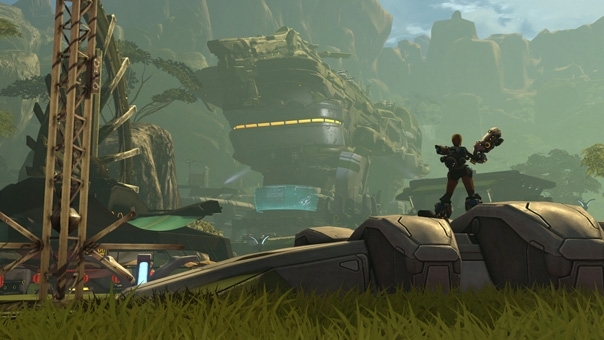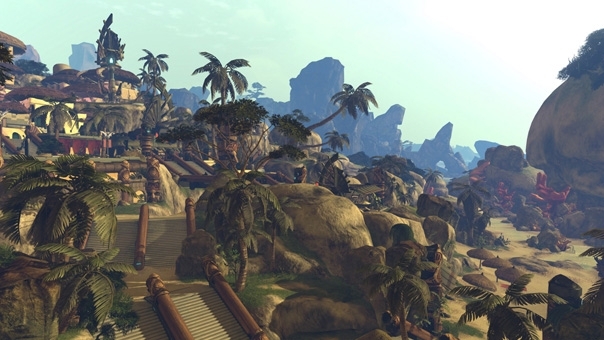FireFall: Interview with David Williams -- Part 1
We talk with Red 5's Lead Class Designer on every aspect of the game. In this first part, we talk about raising the skill cap, class revamps and the eSports toolkit.

With all the emphasis on PvP and eSports, I wanted to make sure that PvE players wouldn’t be missing out. The interesting news from Williams was that the team was again moving away from the traditional MMO mold of raid dungeons and instances. “We don’t see boss monsters and raids as the real end game goal for FireFall. It doesn’t really fit with the game model terrifically well, in our opinion. What we want to do is create army activities, so that you’re getting together with the members of your army to go do things.”
What missions, I hear you ask? Williams gave me a couple of examples, including an army (the FireFall equivalent of a guild) heading into the Aranha-infested Melding to gather resources that could be used to build a vehicle bay. This would allow the army to attach weapons to their vehicles, making travel safer.
There are also improvements happening in the open world in order to make it more dynamic. Another example from Williams was an Aranha infestation occurring near a Chosen dropship, causing the two groups to fight it out. The winners become stronger as a result, which also makes them more dangerous to players. If the Chosen manage to get their hands on Aranha components, they can build a reactor, summon a station, and then use it as a base camp to send out incursions.
The free-form encounters and open-world feel are all part of Red 5’s plan to remove the shackles. While there are mission chains at each of the points of interest, to introduce a location and help you find your way around, after that you’re free to do your own thing. Williams added: “We’re not building a WoW, or an EverQuest, or a game which is quest 1, then quest 2, then quest 3, then quest 4. That’s just not the nature of the game we’re building.”
That said, Williams is eager for both PvE and PvP players to work together, either by providing enough content to keep each group satisfied, or by coming up with ways for them to work together. “We have to make sure that a player who doesn’t care about PvP has enough to do, and enjoy, and feel fulfilled in the open world. If he does, he never has to go play PvP. And we have to make sure that the PvP player can progress his character and get upgrades. He’s going to get really good XP and be able to unlock stuff through that tree a bit faster, but he’s not going to have quite as many resources as the PvE player.”
“We’re probably going to have a particular resource that only comes out of PvP, so that those PvP players are going to have a chit that they can bring to the table that the crafting player’s going to want to get from him.”
Although the concept of groups working together might feel a little alien to some first-person shooter players, Williams thinks that they’ll find the payoff is worth it. “EverQuest is the game that taught RPG players that playing their game with a whole lot of other people, is much cooler and much more fun than playing by yourself. That’s what we want to teach shooter players. The ability to have all of your little moments of triumph get magnified by all of your friends who are online – ‘Ding – Congrats!’ – that is the essence of what makes MMOs.”

Class Warfare
With the overhaul to the Engineer class and Biotech being brought in to replace the Medic, I asked Williams for further background on why these classes received such extensive rework. His responses were all about gameplay – making them fit the feel of the game, but ensuring that it’s not essential to have one in your team. It harks back to wanting the player for what they bring to the party, not for what Battleframe they have kitted out.
Starting out with the Engineer, Williams admitted that “we didn’t like how stationery he was. We’ve taken a lot of his abilities and made them quick to set up and fast deploying, but they don’t last terribly long. So instead of a turret ability, he now has multi-turret. He can toss out a new turret about every fifteen seconds, but they have [very low] health. They only have enough power to last for a minute”
As a result, the Engineer is now heavily flexible, able to throw turrets in trees and on ceilings. They’re also more about tactical play, with short duration near-impenetrable shields and weapon-boosting abilities on tap. They also have two customization paths, with a familiar nest-builder doing what Williams describes as “I want to make this area really painful for you.” The other direction focuses more on being a sapper, with EMP grenades, debuffing and team buffing abilities. Williams believes that good team play will really show players using these abilities together.
With the Medic, Williams expanded on the problems they’d been having. “We found that the medic was making it really hard to make balanced tournament play. You either had a medic and you were winning, or you didn’t and you weren’t. Finding the balance point where the medic is both effective and fun to play as a pure healer, but not necessary [for a team], was just too hard. You could either make them so they were absolutely no fun to play and they weren’t necessary, or they became necessary”.
The solution was to swap to a combat healer in the form of a Biotech. Armed with a damaging weapon that leeches health from enemies, this new class can focus on healing and team support, or poison and enemy debuffing. The idea is that, by being able to mix up both damage and healing abilities, the Biotech becomes enjoyable to play in a wider mix of situations.
That’s all we have for Part 1 of our interview with David Williams, but stick around for the second half! In Part 2, we dig further into class balancing and lore building. Williams also expands on the team’s approach to the beta and his philosophy on free-to-play.
Gareth “Gazimoff” Harmer, Staff Writer



